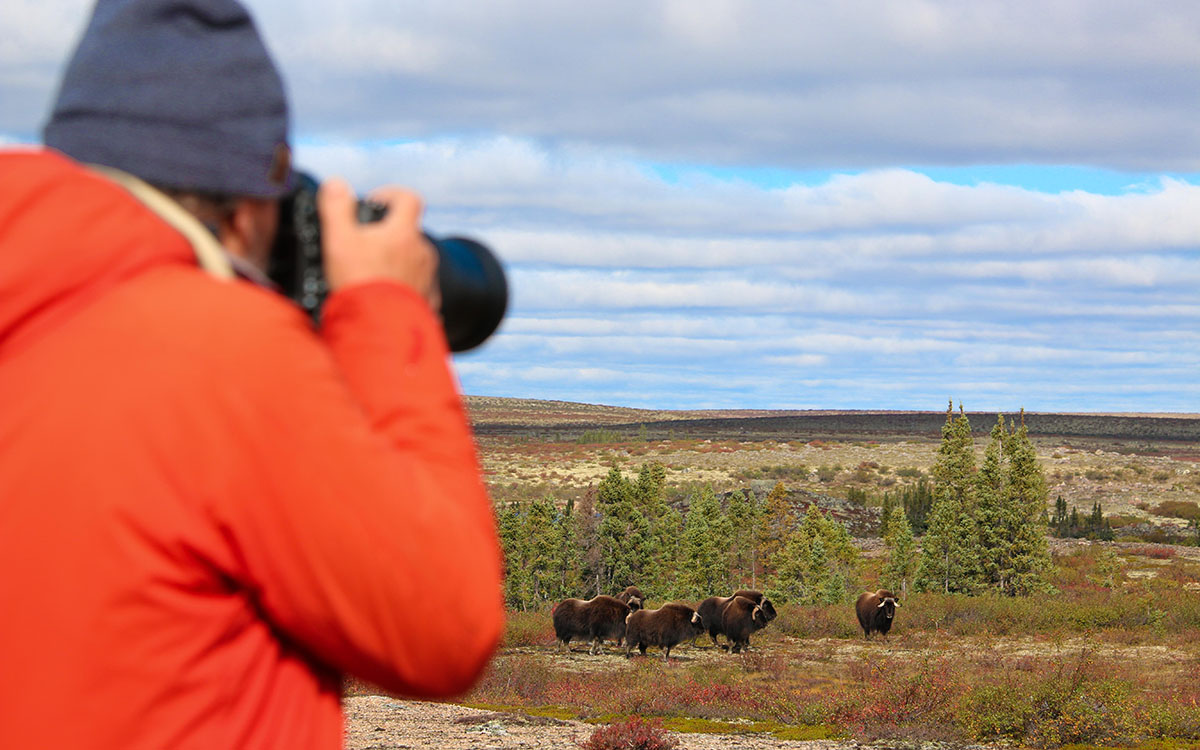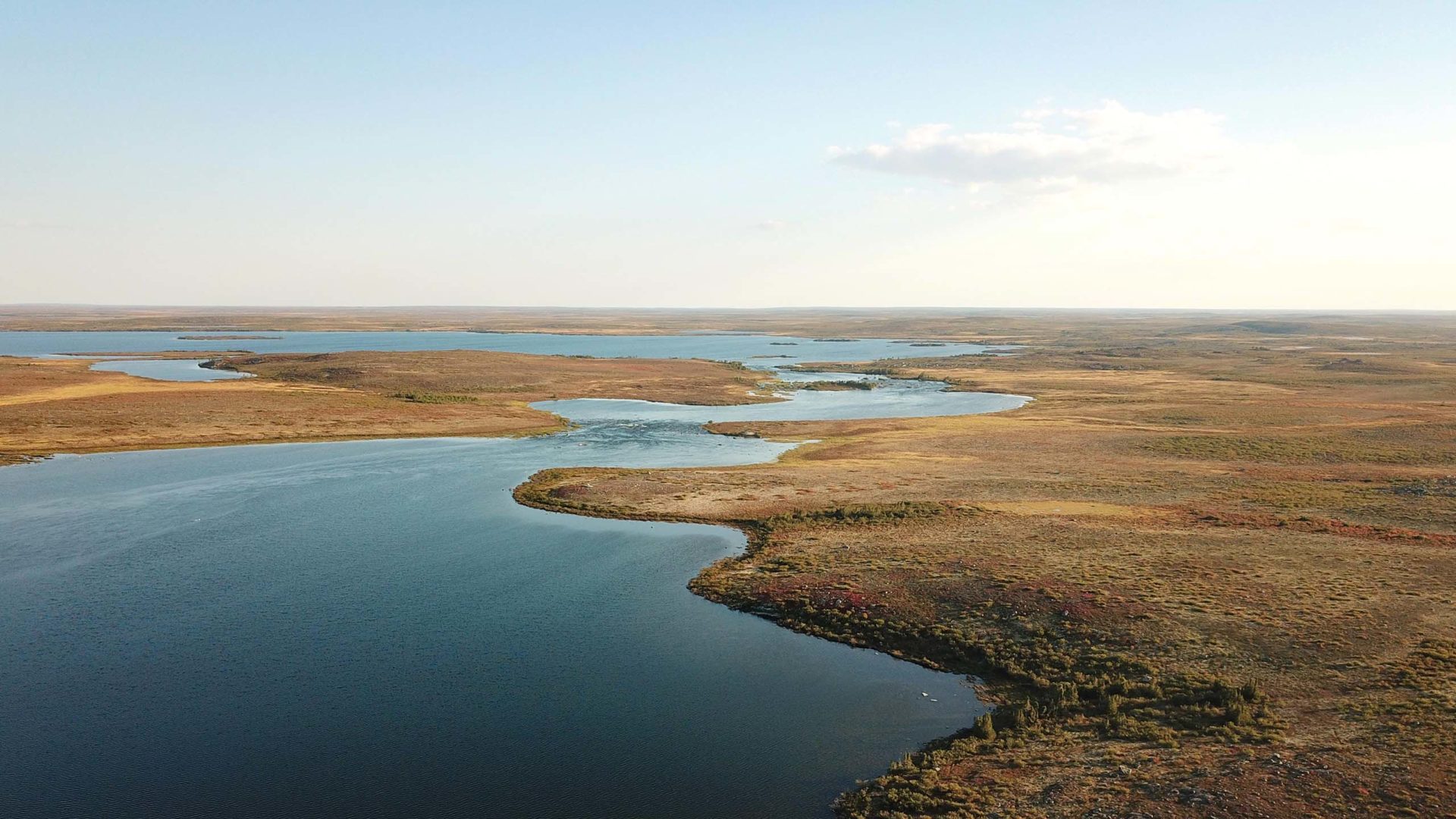
We are told the scientific explanation for Northern Lights involves the collisions between electrically charged particles from the sun entering the Earth’s atmosphere. But when you emerge from your night-time tent, to be overwhelmed by suspended sheets and swells of yellows and greens swaying and dancing in semi-transparent rivers around the horizon, the objective explanation of charged particles doesn’t register. Add in the benevolently watchful constellations of Cassiopeia, Andromeda and Perseus blazing directly above and it seems we are poised between heaven and earth. Like a conductor we wave our arms thinking the symphony of color across the sky can be directed. It is almost enough to make my wife Cheryl and me forgetful of the initial pressing reason for leaving a warm sleeping bag.
This is a phenomenon Alex Hall experienced many times over nearly half a century in his intimate association with the Canadian subarctic tundra, known as the “Barrens”. Unfortunately we never got a chance to hear this from Alex and explore a treasure trove of memories. He was a wildlife biologist with a Master’s degree in wolf ecology. But it was exposure to the Arctic that began a life-long love affair with the Barren Lands and helping others experience and appreciate them through guided wilderness canoe trips.
Our first attempt to travel with him was stymied since he was already booked for the season. Alex took ill and died of cancer the following year. In year three we booked with his protégé Dan Wong only to have Covid slam the Northwest Territories borders shut to outsiders. Fourth time lucky we travel on one of Alex’s secret (and mysterious) rivers with Dan and Evan of Jackpine Paddle, a guiding company based in Yellowknife.
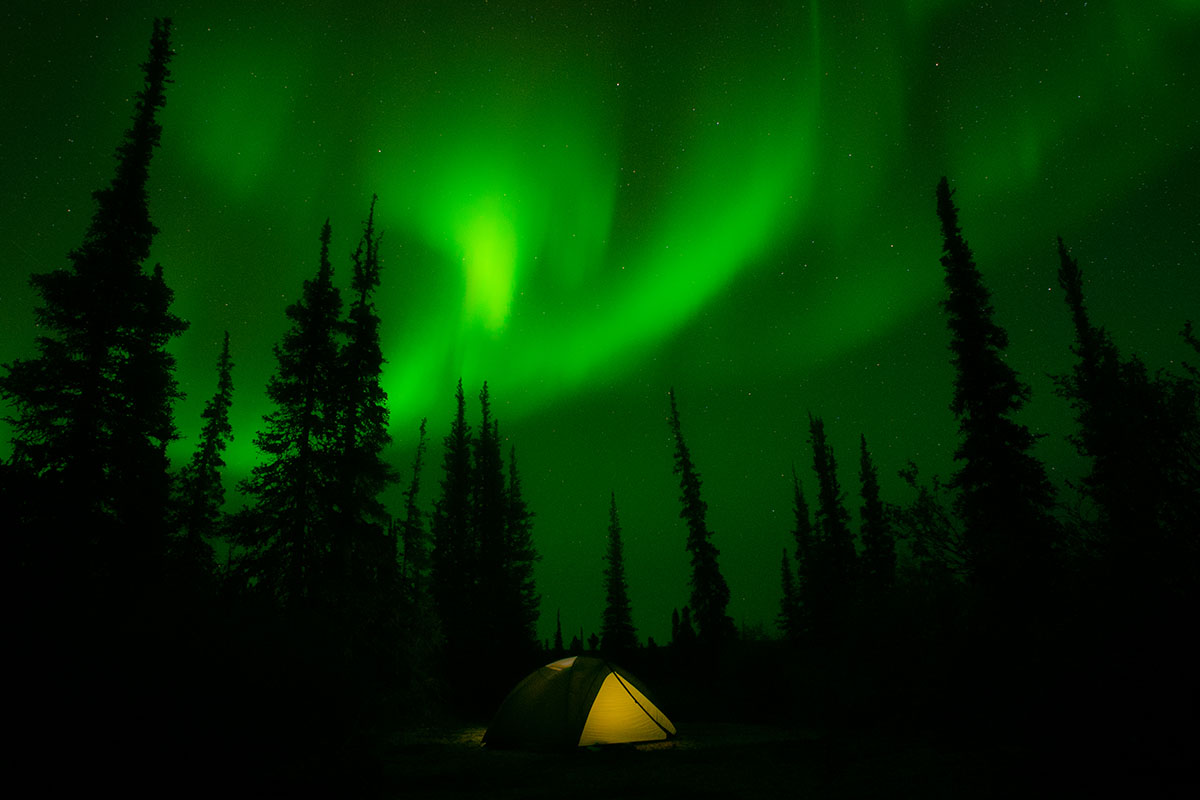
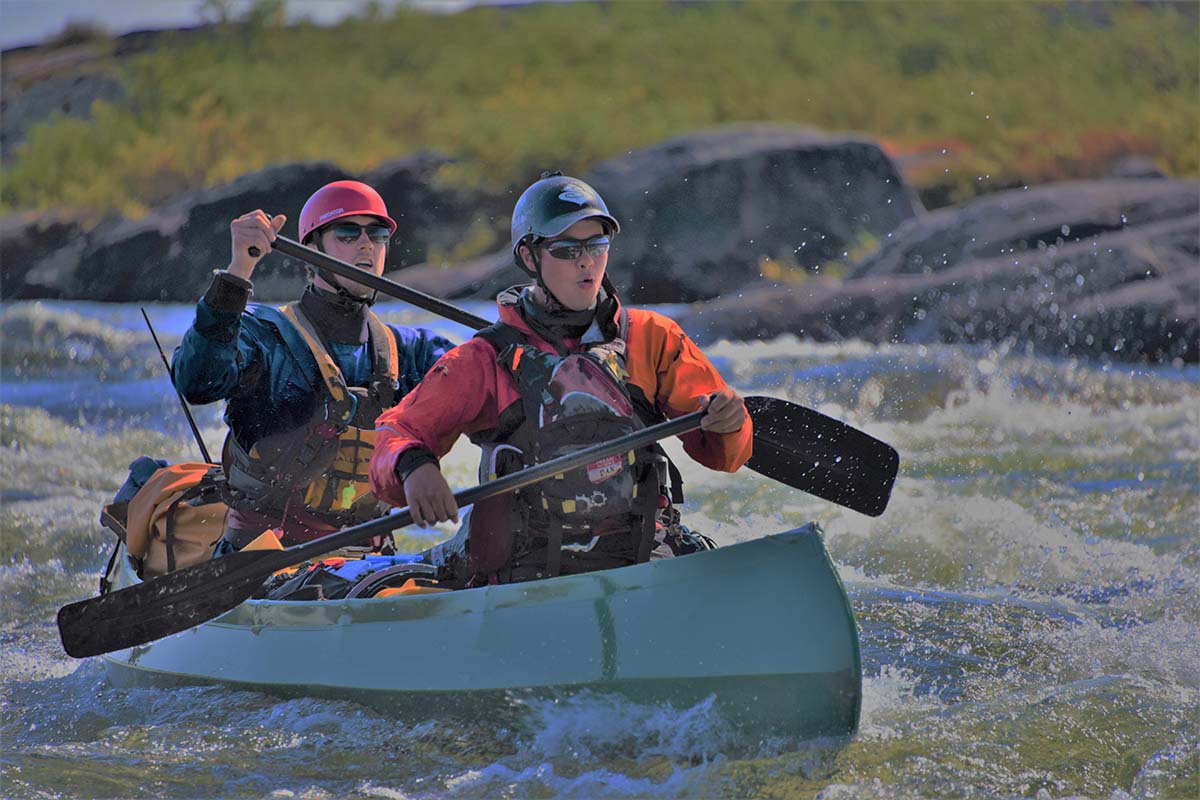
Dan, the owner of Jackpine Paddle is in his mid 30s, dark haired and of medium height with a spare frame. He initially comes across as solemnly serious but that erodes as we get to know each other. It’s obvious he is a masterful organizer, an adept canoeist and an experienced paddling guide, qualities that put many of our fears to bed. As we learn Dan is also socially and environmentally conscious, with experience working for the Territorial government (on public health and climate change), a former city councillor for Yellowknife and someone who at age 18 ran for the Territorial legislature. If I had to describe him in a couple of words it would be quietly impressive.
Evan is in his early 20s, tall, with a perpetual smile. He is endlessly cheerful, even when cooking over a smoky fire in the rain. A soon to be graduate in environmental science, he has learned his lessons well and is a font of information on plants and animals of the Barrens. Dan and Evan kibbutz back and forth, questioning each other in a good natured, teasing manner. But it is also clear they are a team committed to our safety, comfort and maximizing our experience in the Barrens.
Alex defended the secrecy of many of his favorite rivers. An excerpt from a trip information package from his early days reads like a classified document:
“This canoe route is being divulged to you under the strictest confidence. The upper Taltson and Elks Rivers are largely unknown as canoe routes and I’d like to keep them that way. We’ve never seen anyone else on either river and if my clients keep the names of these rivers a secret there is probably little reason why this absence of people can’t continue. Complete isolation and wilderness in its wildest, most pristine state are key ingredients of my trips and can only be maintained in the absence of people. …I trust you will honour my request and keep the names of these rivers a secret.”
Someone must have snitched and now Alex’s secret river is known, but still hardly paddled. That’s what attracted us to the Elk River, to share the reverence Alex had for this place in the Barrens. The river is badly misnamed since the northern extent of any elk herd is more than 500km to the south. Perhaps the current name resulted from some garbled interpretation of an aboriginal word for caribou. In the spirit of correctness and connection, let’s call it Alex’s River.
Alex paddled his river over 40 times and bequeathed a legacy of maps, camp sites, rapid locations, portages and wildlife sightings to Dan. Based on our travels with Dan I think Alex should rest easy as his favorite river is in good hands.
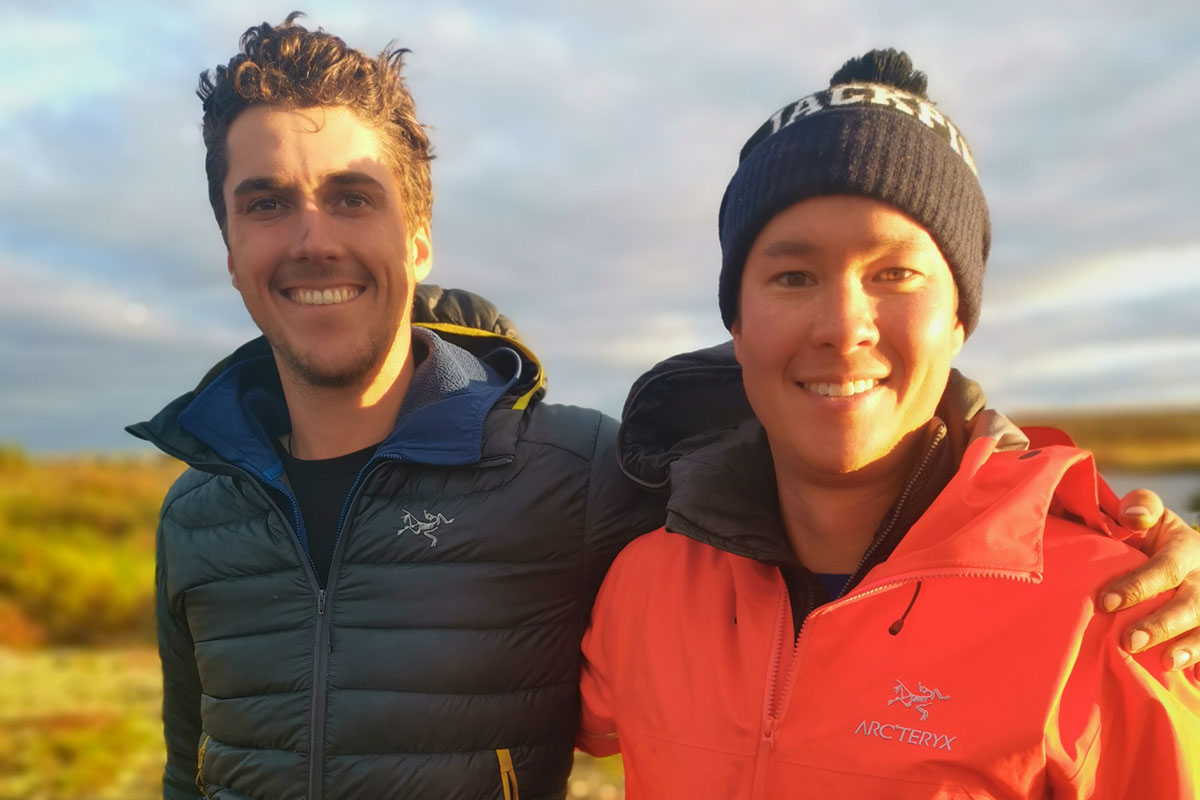
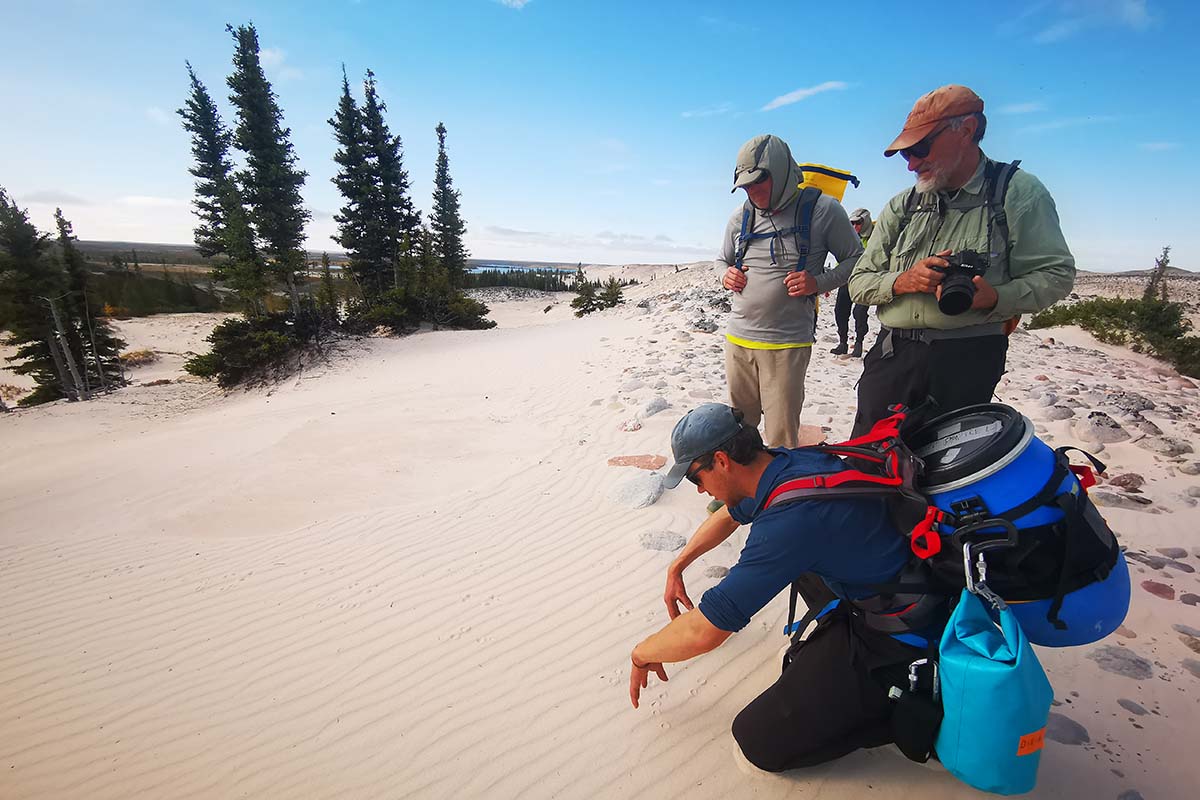
Alex’s River will remain a destination for only the truly committed. Jackpine Paddle advertises it as one of the most remote tundra rivers in Canada. This is no mere promotional boast. Getting there is a seriously long flight and a costly one (but ultimately, worth it).
We fly east from Yellowknife, over Great Slave Lake and far beyond in a Twin Otter on floats. A long journey, but one that provides a perspective that our planet might have been named “Aqua”, not Earth. There seemed to be more water than land. The lakes we fly over are uncounted and mostly unnamed.
Continental glaciation scoured this land and the ice has retreated only recently, as Earth time goes. Massive ice sheets, now melted, have left bare the old Precambrian bones of the Earth, etching it with grooves and gouges. Low growing vegetation ekes out an existence in shallow soils collected between bedrock and water. We fly north of the treeline where trees only have a tenuous toehold in sheltered valleys, beside rivers.
Towards Alex’s River more signs of glaciation become evident. It is a refresher course in the landforms built by glaciers. The ice sheets were like great excavators and conveyor belts. Anything carried on the belts was dumped off when ice sheets slowed forming irregular, rubbly heaps called moraines. Boulders up to the size of pickup trucks were gouged out of bedrock, carried along in the ice flow and then unceremoniously dropped, helter-skelter across the landscape when the ice melted. These boulders, mostly of granite are coated in centuries of multi-colored lichen growth.
The most striking features are eskers, pointed out by Evan from the air. These are long, sinuous ridges of sands and gravels that wind their way through the flat landscape. Rising sometimes over 50 meters above the terrain eskers are the remnants of long dried-up glacial rivers that flowed through tunnels at the base of ice flows. Ice formed the sides and roof of the tunnels and the melt flows carried the lighter sands and gravels. Their loads were deposited on the ice-tunnel bed. As glaciers receded and the surrounding ice melted these former river beds became tall ridges, snaking their way through the Barrens.
The plane touches down in a sheltered bay, bordered by an esker. A steep walk to the top reveals to us that eskers provide pathways for wildlife (tracks of grizzlies, muskoxen and caribou), offer scenic vantage points and are high enough to catch a breeze which briefly defeats abundant biting insects. “We have to pay the land to enjoy it” rationalizes Evan for the depredations of blackflies and mosquitoes. Beyond refuges from insects, eskers contribute to sand beaches on lake shorelines reminiscent of tropical paradises. In our two week trip we cross multiple eskers, camp near many and use them for extensive, exploratory hikes.
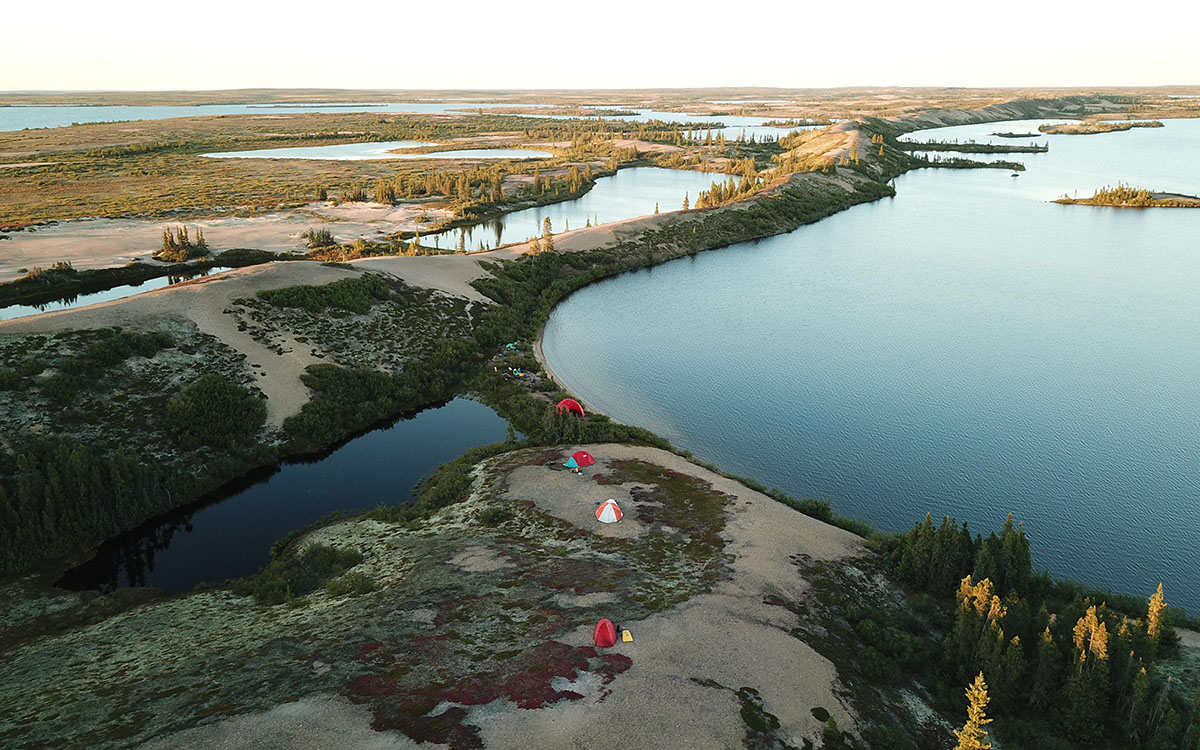
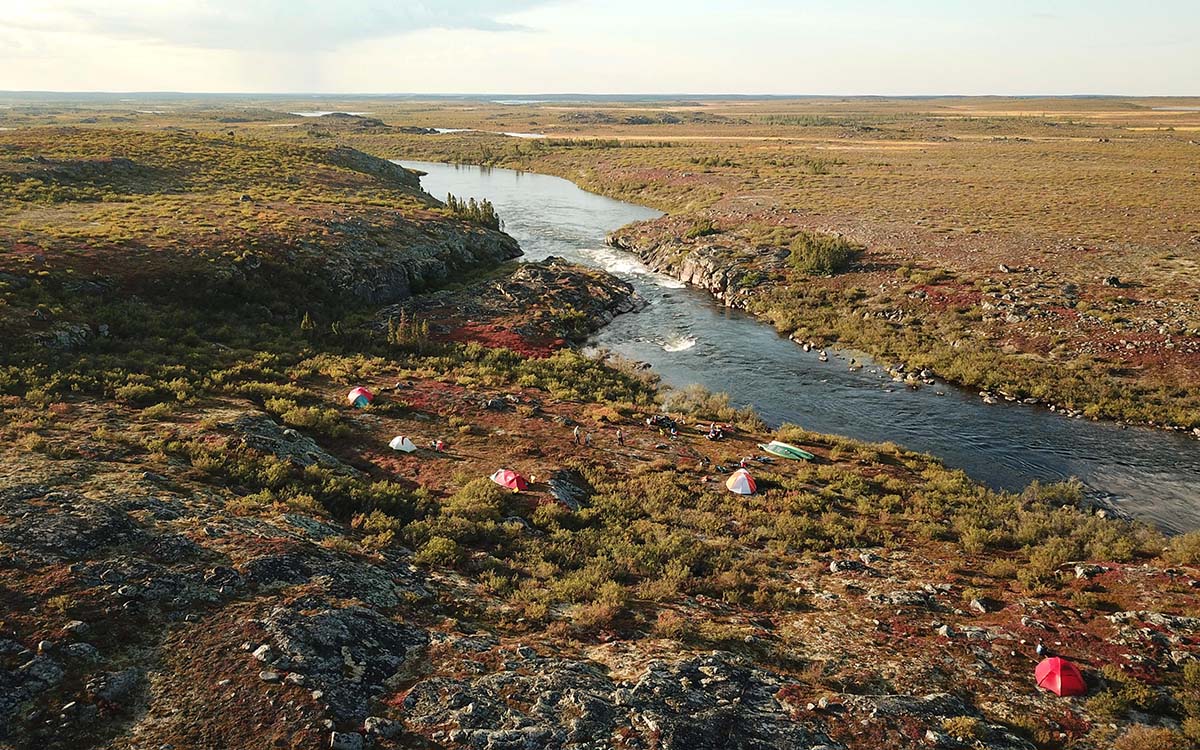
Our first group task (maybe a team-building one) is to assemble our folding canoes, or as Dan puts it, “boat in a bag”. These Norwegian Ally canoes have a tough but flexible PVC exterior, a closed-cell foam floor and are internally framed with a structure of jointed aluminum poles and ribs. The tools for assembly include a mallet with a rubber head and a variety of expressive and unrepeatable phrases. For remote locations like Alex’s River, where the cost of freighting conventional canoes would be prohibitively expensive, these are a welcome adaptation.
Alex’s River is a series of lakes connected by bedrock chutes, boulder rapids and shallow runs. Most of the rapids are runnable, but two required portaging. At the portages the lesson is that in addition to there being no free lunch, there is no light one either. The rest of the fast water is paddled through, albeit with some challenges.
On a boulder-infested rapid Cheryl and I follow Dan, but cannot keep to his line of descent. A boulder hangs us up, from which we are able to wriggle free. That swings the canoe perpendicular to the current and threatens to send us down the rapid backward. With mighty strokes we get to shallow water, jump out and reorient the canoe. At the bottom of the rapid it isn’t clear if the water in the canoe was from the river, a result of cold sweat, or a warmer liquid!
Granite Falls, near the confluence with the Thelon River is an impressive series of white-water rapids and plunges. Our trip ends before the river carves this rapid descent to the valley of the Thelon.
A normal river has a defined channel and discernible flow that even the most unaccomplished neophyte can follow. Alex’s River, by contrast, is mostly made up of lakes with convoluted shorelines, islands, sweeping peninsulas and multiple dead-end bays. Navigating a route through this maze to find the outlet of each is a challenge. Yet, Dan never lost the way, turned correctly every time and found hidden outlets that were invisible to us until the last moment.
Ours is an early autumn voyage so we are treated to a kaleidoscope of vivid color. The bearberry has turned a deep red, almost burgundy. Dwarf birch has hues of oranges, yellows and light reds. Contrasting the deep greens of the white and black spruce are the golden yellows of the autumn tamarack (the conifer that sheds its needles in the fall). The leaves of small cranberry and bog Labrador tea are evergreen, a deep, emerald green, arrayed against the stark white of reindeer lichen. The palette of color combinations seems artistically perfect. Plants of the Barrens do not have the stature of the hardwood forests of eastern Canada but in their own diminutive way are as colorful in the fall.
What isn’t diminutive are the illimitable skies meeting the ancient bones of the earth, with horizons stretching to the curvature of the globe. It is the land of long looks— long, long looks. The scale humbles us.
What also brings us back to earth are the long lake passages. In this place you are left with contradictory feelings about the wind. On one part it is a spirited zephyr that keeps the bugs at bay. In another it turns what could be an easy and pleasurable flat water experience into unnerving swells and waves that require hours of putting your back into constant paddling to make progress. We soon learn a new respect for the term sweat equity as an essential for achieving a wilderness paddling experience.
Every campsite is a combination of utility (flatness for tenting) and beauty (stunning viewscapes). Each produces its own memories. Two of our camps are near caribou ambush points, a narrowing of the river where the animals would cross. Each has large boulders where one can imagine hunters crouching, waiting for animals. The ground is littered in shards of quartzite from the making of stone tools, presumably as hunters waited for caribou. Scrapers, spearpoints and arrowheads lie where they were discarded or lost, each covered with a patina of lichen indicating the antiquity of the site. We consider the stone tools and marvel at a culture that was able to sustain itself in these harsh and unforgiving lands.
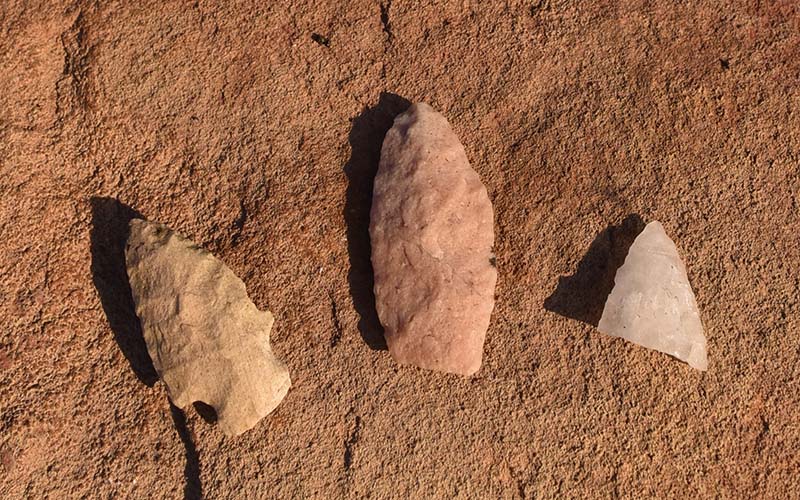
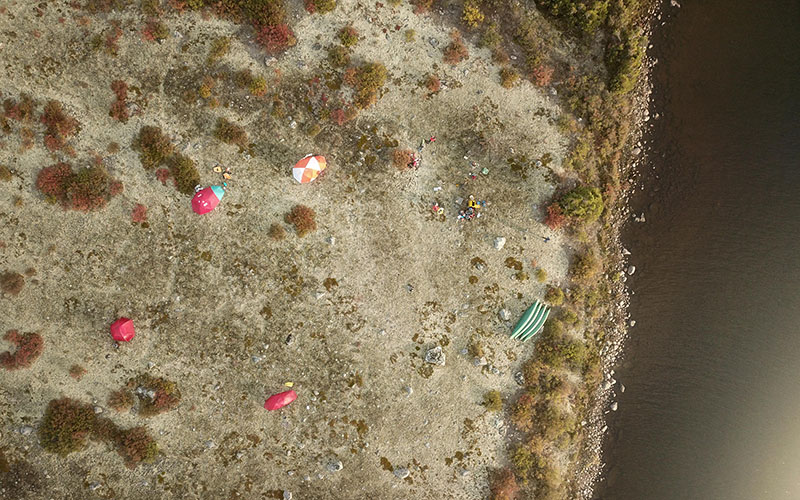
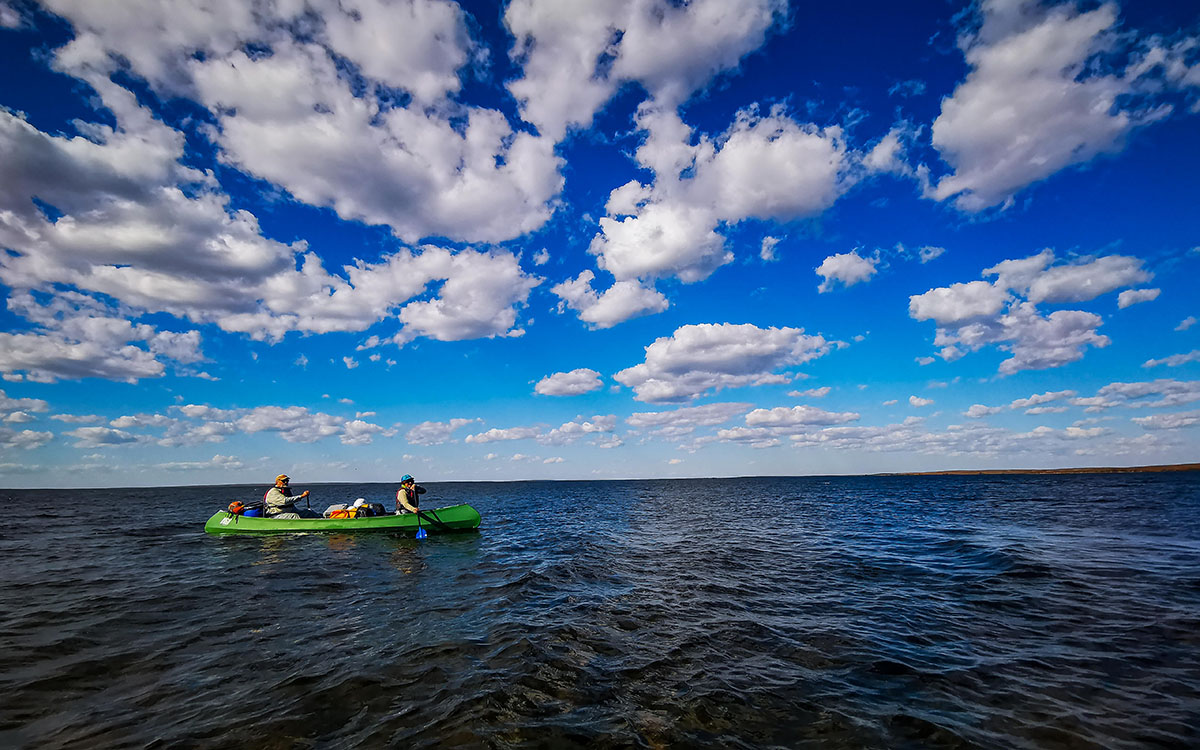
Many of us jumpstart our day with Evan’s authoritative coffee, perked until it had to be coaxed out of the pot. It is strong enough to carry a canoe by itself and fuels us through challenges, surprises and rewards. Our guides planned ahead to ensure our dietary fiber needs are met at breakfast (they can do little for our moral fiber ones) as well as essential calories for the day.
When the going gets tough, the tough eat a good meal, and we do. Dan and Evan spoil us with an array of scratch-built, home-style meals. Dutch-oven delights, fresh fish (lake trout) and salads—all filling, sumptuous and innovatively prepared. Then there are the desserts, notably the bear poop cake, a combination of a dark chocolate-fudge layer, with a lighter milk-chocolate layer forming a dome in the middle and sprinkled with fresh picked cranberries. Fortunately the effort of paddling was roughly proportional to our food intake and a semblance of balance was maintained between intake and expenditure of calories.
Perhaps food is the place where Jackpine Paddle and Alex Hall’s operation diverge. My sister-in-law, Anne was on an earlier Thelon River trip with Alex. She recounts the breakfast and dinner meals were “spartan, utilitarian and somewhat forgettable; fuel rather than a sumptuous repast”. But lunch, by comparison was the not to be missed event. Several varieties of canned fish (including sardines) and canned meats (notably Vienna sausages) were served with Wasa crackers (dismissed by some as glorified cardboard) and supplemented by chocolate bars and orange Tang. In his memory Dan and Evan stage an Alex shore lunch one day.
What is gained in autumn colors is sacrificed in the opportunity to see the abundant bird life of the Barrens, the go-to place for nesting and rearing of so many species. Most have already migrated, yet we still see 21 species. Three species of loons— common, Pacific and red-throated— serenade us with their eerie, sometimes haunting calls. Large skeins of Canada geese pass over us, southward bound. As we move north, one of our fellow paddlers, Robert, muses we might observe and take a lesson from the geese.
We are alert for other wildlife and the sharp eyes of Dan and Evan locate two wolves. One parallels us on shore at a respectful distance, curious perhaps and howls in that spine-tingling, signature sound of wilderness. Howling back elicits a quizzical response.
What initially looks like more boulders, turns out to be muskoxen. Landing on a sandy shore the stalk begins, with us crouched at first, then crawling slowly, using the scant cover of dwarf birch until only a 100 meters separates us from the herd. It feels as if the tactics of our ancestral hunter pasts are being recreated. In our present incarnation only pictures are taken and no stone spears and arrows are flung. We repeat this with another herd, getting even closer and perfecting our ancestor’s hunting method. The fall rut is on and the bulls make a low, rumbling, roar-like bellow.
These ice-age survivors are stocky and compact, with a long, black outer coat resembling a sombre muumuu. They are admirably equipped for Arctic winters with an inner wool layer—qiviut— pieces of which we find ensnarled on shrubs. Horns curve downward toward the face, then out and up to slender tips. The base of the horn for males extends to meet as a solid “boss” of thick horn and bone.
At a subsequent camp yet another herd of muskox appears on the near horizon. I position myself in front of a large boulder as two males, likely the herd bull and a pretender to the throne parade in front of me. The bellows sound ominous and aggressive. As the herd bull walks up the ridge towards me, I notice one side of his horn boss is shattered and the horn split at the base. With the bull at 20 meters and advancing Dan suggests I retreat. During the rut charging and head butting is the ultimate contest to assert dominance between muskox bulls. The injury this bull sustained shows the extreme force exerted in that contact. Clashes over sex can have grave consequences.
One evening, the high clouds lie in waves, almost to the horizon. The sun makes its usual blinding ball of descending fire, disappearing and reappearing as it ducks behind the lines of cloud. At the last space between cloud and land there comes a glory of diffuse, rich light spilling across the vastness of the Barrens. Every shrub and boulder are lit with brilliance and a staircase of light forms across the lake. A bright wedge of orange then flares under the first cloud layer. Each cloud layer shades to a progressively paler orange, fading to a luminescent coral. Suddenly all the color is gone and the clouds go pale grey, backlit with a soft pearl alpenglow. It is one of those recurring moments when being in the Barrens fills us with a deep sense of wonder and appreciation.
Those who do make the long journey from southern destinations will feel the enlightenment that comes from travel through and immersion in the Barrens; the dance of Northern Lights, the exhilarating and liberating feeling of being on a wilderness river or the sight of a herd of muskox, the shaggy survivors of the ice age.
As Alex Hall said, so eloquently and presciently: “It seems that the more you see of the Barren Lands the more you have to return. You can never get enough. A hundred lifetimes wouldn’t be enough.” His ashes lie beneath a simple rock cairn overlooking a favorite campsite, so in a way he has returned to his river.
We feel privileged to have had the opportunity to discover Alex’s secret and favorite river, to have gained an appreciation of a piece of the Barrens, and the man who made this landscape his home for so long. In a contradictory way I hope the river stays largely untraveled as a memorial to Alex, his conservation ethic and vigorous defense of wild rivers. Dan and Jackpine Paddle will continue Alex’s tradition of helping people experience the Barrens in a respectful way and to become advocates for real wilderness.
September, 2021
Lorne and his wife Cheryl live in Lethbridge, Alberta. They and four other canoeists (Anne, John, Robert and Enos) paddled with Jackpine Paddle in late August and early September, 2021.
